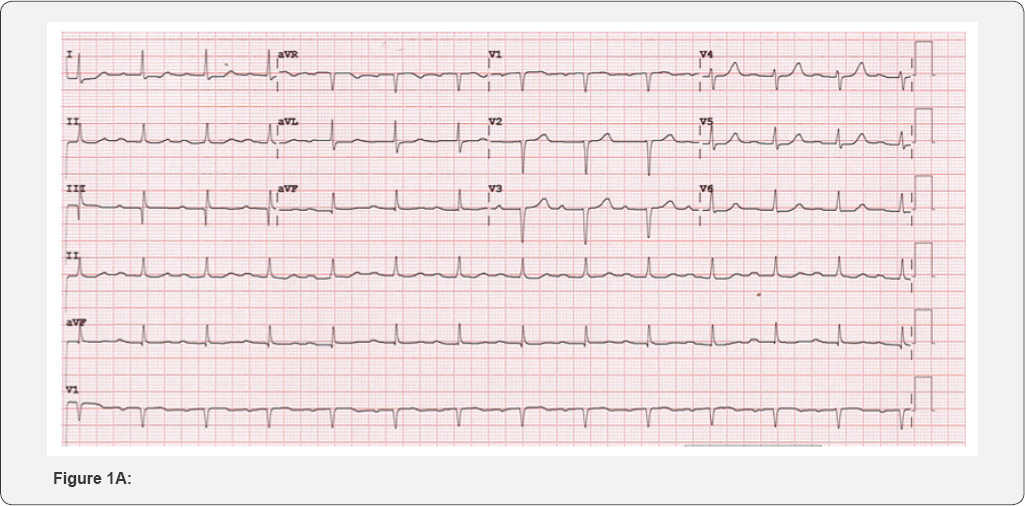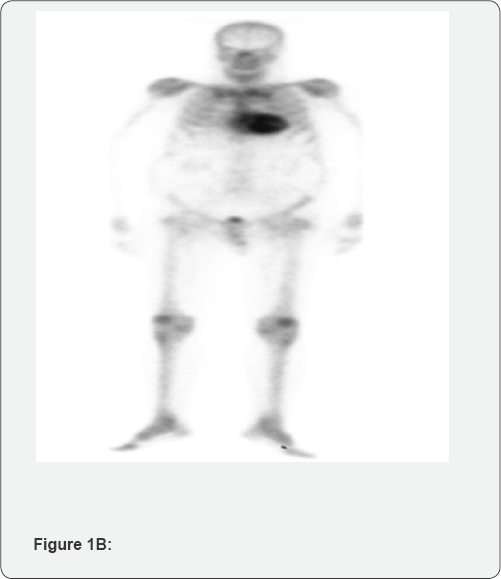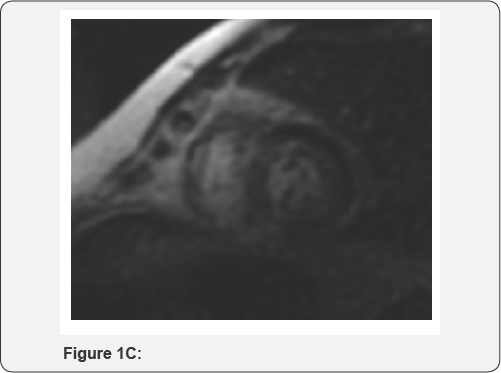Hypertension, Mild Left Ventricular Hypertrophy and Angina Despite Revascularization: What is Behind?-Juniper Publishers
JUNIPER PUBLISHERS-OPEN ACCESS JOURNAL OF CARDIOLOGY & CARDIOVASCULAR THERAPY
Abstract
Introduction: We present the case of a man who remained symptomatic for angina despite percutaneous coronary intervention and optimized medical treatment.
Description of the problem: A 72-years-old man with overweight, dyslipidaemia, hypertension and previously treated prostate cancer is referred for chest pain. After non-invasive evaluation (mild left ventricular hypertrophy -11mm-, no wall motion abnormalities and normal ejection fraction on the echocardiogram, and non-high-risk treadmill test), medical treatment is started for angina. However there is a poor response so an invasive coronariography is done. Severe stenosis in anterior descendent coronary is found and percutaneously treated. During the follow up, the patient remained moderately symptomatic for chest pain.
Questions and problems: Despite that there was little suspicion of a stent restenosis or new obstruction, a stress echo was carried out with a negative result. On the other hand the hypertrophy could be explained by the hypertension, but a cardiac magnetic resonance (MR) was done in order to tissue characterization. That was informed as late gadolinium enhancement appeared only in the interventricular insertion points, which is not consistent with hypertrophic cardiomyopathy. Finally, because of the previous prostate cancer and the possibility of bone metastasis a 99m Tc-3,3-diphosphono-1,2 propanodicarboxylic acid ((99m)Tc-DPD) scintigraphy was performed.
Answer and discussion: The whole heart had a severer adiotracer uptake (score 3) which is diagnostic of transthyretin (TTR) cardiac amyloidosis. No metastatic features were found. The fact that the cardiac MR was reported as above may be a pitfall. It is true that cardiac amyloid was not in the initial differential diagnosis because the ECG findings could be related to the coronary artery disease and the left ventricular hypertrophy could be explained by the hypertension. Apart from microvascular disease, bone metastasis was another option taking into consideration his urologic disease. Scintigraphy was decided to be done because a positive result in the former could have changed dramatically the medical management.
Conclusion and implication: TTR cardiac amyloidosis can be a cause of angina. Clinical suspicion is very important. ((99m)Tc-DPD) scintigraphy is extremely useful to detect and differentiate TTR cardiac amyloid and it should be bear in mind as a ending step in the diagnosis of patients with angina and no other causes found for that.
Introduction
A case of a 72-years-old man who remained symptomatic for angina despite percutenaous coronary intervention and optimized medical treatment is presented.
Description
72-years-old man was referred by his primary care doctor for chest pain. He had overweight, dyslipidaemia, hypertension and he received radiotherapy for prostate cancer in ten years ago. The chest pain occurred with physical activity and no threshold changes were documented from the beginning of symptoms 4 months before. The electrocardiogram (ECG) was in sinusal rhythm and first degree auriculo-ventricular block and a “pseudo infarct” pattern in right precordial leads were present (Figure 1A). Blood panel, renal and hepatic function, glucose and total cholesterol were within normal limits. The echocardiogram revealed mild (11mm) and symmetric left ventricular (LV) hypertrophy and normal LV ejection fraction but no wall motion abnormalities or other abnormal features. He completed 9 minutes Bruce treadmill test: 100% predicted maximum heart rate, 10.30 METS, mild to moderate chest pressure at the time subtle changes in ST segments appeared (less than 1mm depression in inferior leads) at maximum exercise. Reaching the diagnosis of stable angina, anti- ischaemic medical treatment was started and follow-up programmed as recommended. After 7 months the patient had poor relief of symptoms so an invasive coronary angiography was performed. A significant single vessel disease (focal severe obstruction in medium anterior descendent coronary) was treated with single bioabsorbable stent. In addition, ulcerated atheromatous plaque in the left main coronary artery which did not cause stenosis was found. 3 months later, he continued with chest pain, milder and usually related with exercise.

Despite the fact that there was little suspicion of a stent restenosis or progression of the ulcer, a stress echocardiogram (with exercise) was carried out. The obtained result was negative for neither ischemia nor inducible pulmonary hypertension. The hypertrophy (which increased up to 14mm in that time) could be explained by the hypertension but a cardiac magnetic resonance (MR) was ordered for tissue characterization. It was done in an external centre and it was informed as: normal myocardial suppression and mild late gadolinium enhancement in the interventricular insertion points. So, the possibility of hypertrophic cardiomyopathy or infiltrative cardiomyopathy was low. After excluding inducible ischemia, valve disease, LV dysfunction and inducible pulmonary hypertension, the idea of lung or bone diseases arose. Taking into consideration that the patient suffered prostate cancer in the past and that tumour marker relapse appeared, a 99m Tc- 3,3-diphosphono-1,2 propanodicarboxylic acid ((99m)Tc-DPD) scintigraphy was performed (3 weeks later than cardiac MR). With this image technique, no metastasis was identified, but there was surprisingly radiotracer uptake in the heart (both ventricles, higher signal than bone nearby -score III-) (Figure 1B). This finding strongly suggested transthyretin (TTR) cardiac amyloidosis. The patient was then referred to our reference centre for considering endomyocardial biopsy.

Discussion

The presented case is a nice example for the differential diagnosis of chest pain. Looking backwards, it is reasonable to think that the ECG could suggest infiltrative myocardial [1] disease but on the other hand, that pattern could have been also explained by ischemia in the left anterior coronary territory which was confirmed by angiogram. Secondly, it is remarkable that the LV wall thickness increased during 16 months approximately, despite treatment and good blood pressure control [2]. No systemic manifestations of other diseases were apparent. Coronary flow reserve and ergonovine test were not achieved but the patient was under not only high doses of antischemic drugs but also third line association, and the symptoms relief was poor. Pitfall is presumed to occur in the cardiac MR study related to myocardial signal suppression because the attached images (evaluated by expert but not for diagnostic purpose) were unconvincing for a normal suppression to have been achieved (Figure 1C).
Once the cardiac causes of chest pain were comprehensive evaluated, other non-cardiac causes for that needed to be addressed. The main patient's personal history which directed the following step to take was the prostate cancer. That was treated 10 years ago but there was evidence of new tumour marker elevation. ((99m)Tc-DPD) scintigraphy was implemented driven by the possibility of bone metastasis. The result of the technique was doubling useful: it did not only exclude metastasis but it did recognized TTR cardiac amyloid which has a specific management.
TTR amyloid wild type affects the heart exclusively. Elderly men are primarily affected. Following features should be suspicious of TTR cardiac amyloid: pseudoinfarct in ECG, LV hypertrophy and pericardial effusion on the echocardiogram, abnormal gadolinium kinetics in cardiac MR, and carpal tunnel syndrome. The proposed diagnostic algorithm based on combination scintigraphy and blood test has demonstrated high specificity and positive predictive value for TTR cardiac amyloid [3,4]. This disease could have a specific treatment.
In the end, bone scintigraphy did considerably change the course of the patient meaning diagnosis, management and future treatment.
Conclusion and Learning Points
TTR cardiac amyloidosis can be a cause of angina. Clinical suspicion is very important. Image techniques should be performed and evaluated by experts. ((99m)Tc-DPD) scintigraphy is extremely useful to detect and differentiate TTR cardiac amyloid and it should be bear in mind as an ending step in the diagnosis of patients with angina and no other causes found for that and/or limitations in previous non-invasive image techniques.
For more Open Access Journals in Juniper Publishers
please click on: https://juniperpublishers.com/open-access.php
For more articles in Open Access Journal of Cardiology & Cardiovascular Therapy please click on: https://juniperpublishers.com/jocct/index.php


Comments
Post a Comment